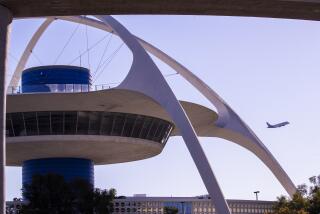FAA Seeks to Widen Safety Margin : Cerritos Disaster Prompted Steps to Prevent Air Collisions
- Share via
In the months since the disastrous Aeromexico accident over Cerritos that claimed 82 lives, the Federal Aviation Administration has taken a number of steps designed to lessen the likelihood of air collisions here and across the nation.
The FAA cites its actions as evidence that the agency is acting promptly to improve an air traffic control system that it says provides an “extremely high” margin of safety.
But critics--among them the National Transportation Safety Board--warn that there still appears to be “an erosion of safety” in a system that is increasingly prone to error.
The first of the steps taken locally in the wake of the Aeromexico disaster was announced in February, when H. C. (Mac) McClure, director of the FAA’s Western-Pacific region, released figures showing that the agency had begun to “turn up the heat” on pilots who violate the restricted airspace around Los Angeles International Airport--the airspace in which the fatal collision occurred.
In the 5 1/2 months after the crash, for example, the FAA said that 39 aviators had been warned they could lose their pilot’s certification because of unauthorized intrusion into the Los Angeles Terminal Control Area (TCA). Twenty-four such warnings had been issued in the 12 months before the Cerritos disaster.
In addition, McClure said, the FAA had begun seminars to familiarize pilots with the perimeters of TCAs, which differ from one major airport to another. While most are shaped like inverted wedding cakes, their configurations tend to be irregular, with varying maximum and minimum altitudes.
A few weeks after McClure’s announcement, Dick Morrison, the region’s special projects officer, announced that air traffic controllers in California, Arizona, Nevada and Hawaii were undergoing “reinforcement” training to help them spot and issue warnings about aircraft that might be heading for a collision.
Emphasis on Training
As part of their regular refresher courses, controllers receive expanded instruction on radar simulators that is designed specifically to provide a better understanding of approved procedures for keeping aircraft separated, Morrison said.
The FAA also had announced plans to implement broad changes to “restructure” the controlled airspace over Southern California.
The agency said the coastal approach route from the south used by the ill-fated Aeromexico jetliner would be replaced by a new route farther inland, permitting commercial and business aircraft to more easily avoid potential contact with the hundreds of small planes based at coastal airports in Orange and Los Angeles counties.
Using the new route, jetliners heading for Los Angeles from San Diego and points southeast will turn inland at Oceanside and fly north to Pomona, more than 20 miles northeast of the congested skies over Cerritos, where the Aeromexico collision occurred. Once over Pomona, at an altitude no lower than 15,000 feet (the Cerritos collision occurred at 6,589 feet), the jets will turn west and head for LAX.
The FAA said the inland approach route to Los Angeles from the north would be supplemented with a new coastal approach route, reducing the “bunching” of southbound aircraft headed for the Los Angeles Basin.
Using this new route, the airliners headed for LAX would be culled from the about 750 commercial aircraft that fly into Los Angeles-area airports each day from San Francisco and other points northwest. These LAX-bound planes would turn south earlier than the others. The new routes are being implemented over an 18-month period.
The FAA also moved up by four years--to next Dec. 1 from Jan 1, 1992--the date when aircraft operating within all TCAs will be required to carry Mode “C” transponders--devices that give air traffic controllers a continuous reading of a plane’s altitude.
The FAA also said it is considering reshaping the TCA at Los Angeles and other major air centers to standardize the configuration of TCAs across the country. Officials said this would make them more recognizable for all pilots and allow more uniform approach and departure patterns. These proposed changes probably will be announced by the end of this month.
In addition, the agency said it is shifting some of the routing and tracking tasks performed at the regional air traffic control hub in Palmdale to the terminal radar approach control centers handling planes approaching and departing from the area’s major airports. Officials said this would reduce the “complexity” of controlling aircraft as they move from one block of controlled airspace to another.
More to Read
Inside the business of entertainment
The Wide Shot brings you news, analysis and insights on everything from streaming wars to production — and what it all means for the future.
You may occasionally receive promotional content from the Los Angeles Times.










